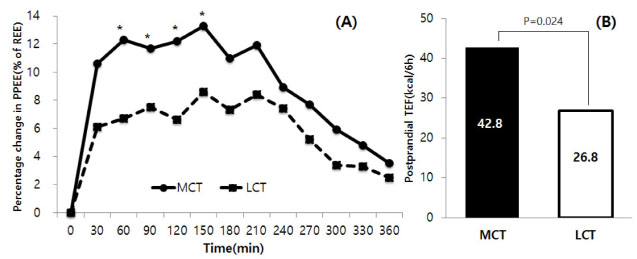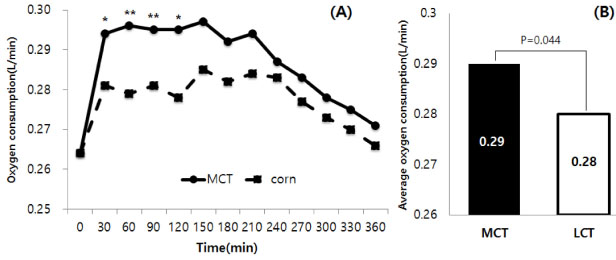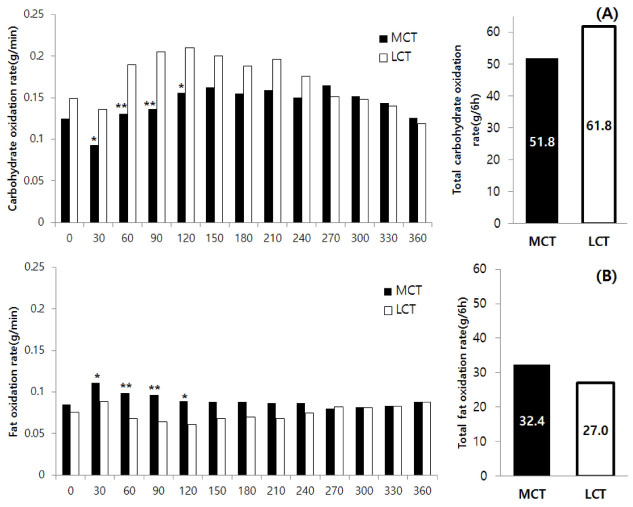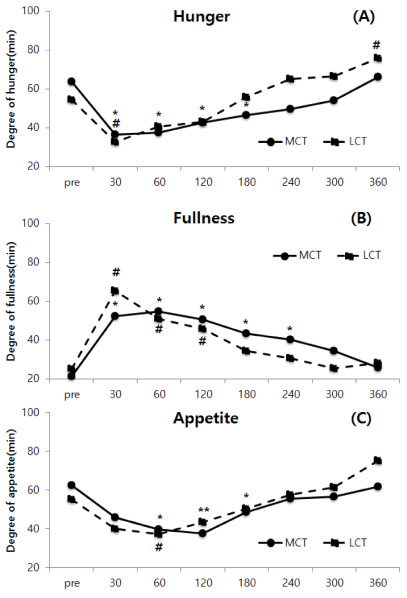Korean J Community Nutr.
2015 Dec;20(6):468-478. 10.5720/kjcn.2015.20.6.468.
Thermic Effect of Food, Macronutrient Oxidation Rate and Satiety of Medium-chain Triglyceride
- Affiliations
-
- 1Department of Food and Nutrition, Gangneung-Wonju National University, Gangneung, Korea. ekkim@gwnu.ac.kr
- KMID: 2152500
- DOI: http://doi.org/10.5720/kjcn.2015.20.6.468
Abstract
OBJECTIVES
The objective of this study was to evaluate the thermic effects, the macronutrient oxidation rates and the satiety of medium-chain triglycerides (MCT).
METHODS
The thermic effects of two meals containing MCT or long-chain triglycerides (LCT) were compared in ten healthy men (mean age 24.4 +/- 2.9 years). Energy content of the meal was 30% of resting metabolic rate of each subject. Metabolic rate and macronutrient oxidation rate were measured before the meals and for 6 hours after the meals by indirect calorimetry. Satiety was estimated by using visual analogue scales (VAS) at 8 times (before the meal and for 6 hours after meal).
RESULTS
Total thermic effect of MCT meal (42.8 kcal, 8.0% of energy intake) was significantly higher than that (26.8 kcal, 5.1% of energy intake) of the LCT meal. Mean postprandial oxygen consumption was also significantly different between the two types of meals (MCT meal: 0.29 +/- 0.35 L/min, LCT meal: 0.28 +/- 0.27 L/min). There were no significant differences in total postprandial carbohydrate and fat oxidation rates between the two meals. However, from 30 to 120 minutes after consumption of meals, the fat oxidation rate of MCT meal was significantly higher than that of the LCT meal. Comparison of satiety values (hunger, fullness and appetite) between the two meals showed that MCT meal maintained satiety for a longer time than the LCT meal.
CONCLUSIONS
This study showed the possibility that long-term substitution of MCT for LCT would produce weight loss if energy intake remained constant.
MeSH Terms
Figure
Reference
-
1. Schutz Y, Bessard T, Jequier E. Diet-induced thermogenesis measured over a whole day in obese and nonobese women. Am J Clin Nutr. 1984; 40(3):542–552.2. Reed GW, Hill JO. Measuring the thermic effect of food. Am J Clin Nutr. 1996; 63(2):164–169.3. Ogawa A, Nosaka N, Kasai M, Aoyama T, Okazaki M, Igarashi O. Dietary medium- and long-chain triacylglycerols accelerate diet-induced thermogenesis in humans. J Oleo Sci. 2007; 56(6):283–287.4. Hill JO, Peters JC, Yang D, Sharp T, Kaler M, Abumrad NN. Thermogenesis in humans during overfeeding with mediumchain triglycerides. Metab. 1989; 38(7):641–648.5. Seaton TB, Welle SL, Warenko MK, Campbell RG. Thermic effect of medium-chain and long-chain triglycerides in man. Am J Clin Nutr. 1986; 44(5):630–634.6. de Jonge L, Bray GA. The thermic effect of food and obesity: A critical review. Obes Res. 1997; 5(6):622–631.7. von Voit C. Untersuchungen uber die Respiration. Ann Chem Pharm. 1862; 3(2):52–70.8. Acheson KJ. Influence of autonomic nervous system on nutrientinduced thermogenesis in humans. Nutr. 1993; 9(4):373–380.9. Westerterp KR. Diet induced thermogenesis. Nutr Metab. 2004; 1(1):5.10. Welle S, Lilavivat U, Campbell RG. Thermic effect of feeding in man: increased plasma norepinephrine levels following glucose but not protein or fat consumption. Metabolism. 1981; 30(10):953–958.11. Kim MH, Kim EK. Thermic effect of food and macronutrient oxidation rate in men and women after consumption of a mixed meal. Korean J Nutr. 2011; 44(6):507–517.12. Oh SH, Park JJ, Choi IS, No HK. Effects of cellulose and pectin on diet-induced thermogenesis in young women. J Korean Soc Food Sci Nutr. 2007; 36(2):194–200.13. Tsani AF, Kim MH, Kim EK. Comparison of thermogenic effect between meals containing protein predominantly from animal and plant sources. Int J Biosci Biochem Bioinform. 2012; 2(5):320–323.14. Lee MJ, Tsani AF, Kim EK. Thermic effect of food, macronutrient oxidation rate and satiety of high-fat meals with butter and sesame oil on healthy adults. Korean J Community Nutr. 2012; 17(2):215–225.15. Seo GH, Seo JS, Lee BH, Lee SG, Choi MS. Advanced Nutrition for Clinical Dietitian. 1st ed. Paju: Jigu publishing Co;2011. p. 71–177.16. Paddon-Jones D, Westman E, Mattes RD, Wolfe RR, Astrup A, Westerterp-Plantenga M. Protein, weight management, and satiety. Am J Clin Nutr. 2008; 87(5):1558S–1561S.17. Holt SH, Miller JC, Petocz P, Farmakalidis E. A satiety index of common foods. Eur J Clin Nutr. 1995; 49(9):675–690.18. Donini LM, Savina C, Cannella C. Eating habits and appetite control in the elderly: the anorexia of aging. Int Psychogeriatr. 2003; 15(1):73–87.19. Mayer J. Glucostatic mechanism of regulation of food intake. N Engl J Med. 1953; 249(1):13–16.20. Mayer J. Regulation of energy intake and the body weight: the glucostatic theory and the lipostatic hypothesis. Ann N Y Acad Sci. 1955; 63(1):15–43.21. Melanson KJ, Westerterp-Plantenga MS, Saris WH, Smith FJ, Campfield LA. Blood glucose patterns and appetite in timeblinded humans: carbohydrate versus fat. Am J Physiol. 1999; 277(2):R337–R345.22. Randle PJ, Garland PB, Hales CN, Newsholme EA. The glucose fatty acid cycle: its role in insulin sensitivity and the metabolic disturbances of diabetes mellitus. Lancet. 1963; 281(7285):785–789.23. Van Wymelbeke V, Louis-Sylvestre J, Fantino M. Substrate oxidation and control of food intake in men after a fat-substitute meal compared with meals supplemented with an isoenergetic load of carbohydrate, long-chain triacylglycerols, or medium-chain triacylglycerols. Am J Clin Nutr. 2001; 74(5):620–630.24. Poppitt SD, Strik CM, MacGibbon AKH, McArdle BH, Budgett SC, McGill AT. Fatty acid chain length, postprandial satiety and food intake in lean men. Physiol Behav. 2010; 101(1):161–167.25. Weir JB. New methods for calculating metabolic rate with special reference to protein metabolism. J Physiol. 1949; 109(1-2):1–9.26. Matthews JN, Altman DG, Campbell MJ, Royston P. Analysis of serial measurements in medical research. Br Med J. 1990; 300(6719):230–235.27. Segal KR, Edaño A, Blando L, Pi-Sunyer FX. Comparison of thermic effects of constant and relative caloric loads in lean and obese men. Am J Clin Nutr. 1990; 51(1):14–21.28. Péronnet F, Massicotte D. Table of nonprotein respiratory quotient: an update. Can J Sport Sci. 1991; 16(1):23–29.29. WHO Expert Consultation. Appropriate body-mass index for Asian populations and its implications for policy and intervention strategies. Lancet. 2004; 363(9403):157–163.30. Storlien LH, Huang XF, Lin S, Xin X, Wang HQ, Else PL. Dietary fat subtypes and obesity. World Rev Nutr Diet. 2001; 88(1):148–154.31. Mercer SW, TrayHurn P. Effect of high fat diets on the thermogenic activity of brown adipose tissue in cold acclimated mice. J Nutr. 1984; 114:1151–1158.32. Flatt JP, Ravussin E, Acheson KJ, Jéquier E. Effects of dietary fat on postprandial substrate oxidation and on carbohydrate and fat balances. J Clin Invest. 1985; 76(3):1019–1024.33. Jones PJ, Pencharz PB, Clandinin MT. Whole body oxidation of dietary fatty acids: implications for energy utilization. Am J Clin Nutr. 1985; 42(5):769–777.34. DeLany JP, Windhauser MM, Champagne CM, Bray GA. Differential oxidation of individual dietary fatty acids in humans. Am J Clin Nutr. 2000; 72(4):905–911.35. St-Onge MP, Ross R, Parsons WD, Jones PJ. Medium-chain triglycerides increase energy expenditure and decrease adiposity in overweight men. Obes Res. 2003; 11(3):395–402.36. Krotkiewski M. Value of VLCD supplementation with medium chain triglycerides. Int J Obes. 2001; 25(9):1393–1400.37. Dulloo AG, Fathi M, Mensi N, Cirardier L. Twenty-four-hour energy expenditure and urinary catecholamines of humans consuming low-to-moderate amounts of medium-chain triglycerides: a dose-response study in a human respiratory chamber. Eur J Clin Nutr. 1996; 50(3):152–158.38. Baba N, Bracco EF, Hashim SA. Enhanced thermogenesis and diminished deposition of fat in response to overfeeding with diet containing medium chain triglyceride. Am J Clin Nutr. 1982; 35(4):678–682.39. Scalfi L, Coltorti A, Contaldo F. Postprandial thermogenesis in lean and obese subjects after meals supplemented with mediumchain and long-chain triglycerides. Am J Clin Nutr. 1991; 53(5):1130–1133.40. Levine JA. Measurement of energy expenditure. Public Health Nutr. 2005; 8(7A):1123–1132.41. St-Onge MP. Dietary fats, teas, dairy, and nuts: potential functional foods for weight control? Am J Clin Nutr. 2005; 81(1):7–15.42. Ruderman NB, Goodman MN. Regulation of ketone body metabolism in skeletal muscle. Am J Physiol. 1973; 224(6):1391–1397.43. Matsuo T, Matsuo M, Taguchi N, Takeuchi H. The thermic effect is greater for structured medium-and long-chain triacylglycerols versus long-chain triacylglycerols in healthy young women. Metabolism. 2001; 50(1):125–130.
- Full Text Links
- Actions
-
Cited
- CITED
-
- Close
- Share
- Similar articles
-
- Thermic Effect of Food, Macronutrient Oxidation Rate and Satiety of High-fat Meals with Butter and Sesame Oil on Healthy Adults
- Thermic Effect of Food and Macronutrient Oxidation Rate in Men and Women after Consumption of a Mixed Meal
- Comparative Analysis of Perception Volume, Intake Volume, and Satiety Rate of Rice, Soup and Side Dishes Using Tableware and Food Tray
- Effect of plate size on meal energy intake in normal weight women
- Effects of Food Consumption Monitoring Using Modified Rice Bowls on Food Intake, Satiety Rate, and Eating Rate






